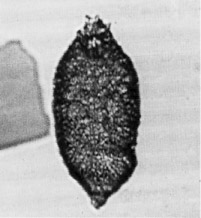 Lithopera
(Glomaria) thornburgi Sanfilippo and Riedel
Lithopera
(Glomaria) thornburgi Sanfilippo and Riedel Lithopera
(Glomaria) thornburgi Sanfilippo and Riedel
Lithopera
(Glomaria) thornburgi Sanfilippo and RiedelLithopera (Glomaria) thornburgi Sanfilippo and Riedel, 1970, p.455, pl.2, figs.4-6
Spindle-shaped shell, tapering equally at both ends. Cephalis spherical, apparently poreless, completely enclosed in the spongy thoracic wall. Thorax spindle-shaped, tapering and closing distally, sometimes with a short terminal spine or acute cone. No third segment distinguished. Thoracic wall thick, of spongy meshwork, especially in the proximal half. The thoracic wall adjacent to the cephalis is of spongy mesh-work and has some straight, rodlike elements developed within and projecting from it, which are probably the primary spines (Sanfilippo and Riedel, 1970).
Based on 35 specimens. Total length 140-285 µm. Maximum breadth usually 85-135 µm, but rarely to 150 µm (Sanfilippo and Riedel, 1970).
Shell elongate, spindle-shaped, pointed at both ends. Cephalis enclosed in spongy thoracic wall (Riedel and Sanfilippo, 1978a).
L. thornburgi is distinguished from L. baueri Sanfilippo and Riedel (1970, p.455, pl.2, figs.1-2) in that both ends are tapered and pointed, and the cephalis is enclosed in the spongy thoracic wall (Sanfilippo et al., 1985).
This spongy, spindle-shaped theoperid, tapered at both ends, has the cephalis completely enclosed in the thoracic wall. In some specimens, the distal part of the shell is composed of small irregularly spaced pores, rather than spongy material, and there is sometimes a contour change, though this is not accompanied by an internal ring (Sanfilippo et al., 1985).
This species is found in late middle Miocene samples from latitudes lower than 40° in the Indian and Pacific Oceans and the Mediterranean and Caribbean Seas. Its morphotypic first appearance lies within the Dorcadospyris alata Zone and its morphotypic last appearance lies within the Diartus petterssoni Zone.
L. thornburgi appears to have evolved from L. renzae, and to have left no descendants.
Additional illustrations can be found in Riedel and Sanfilippo, 1978a, pl.6, fig.12.